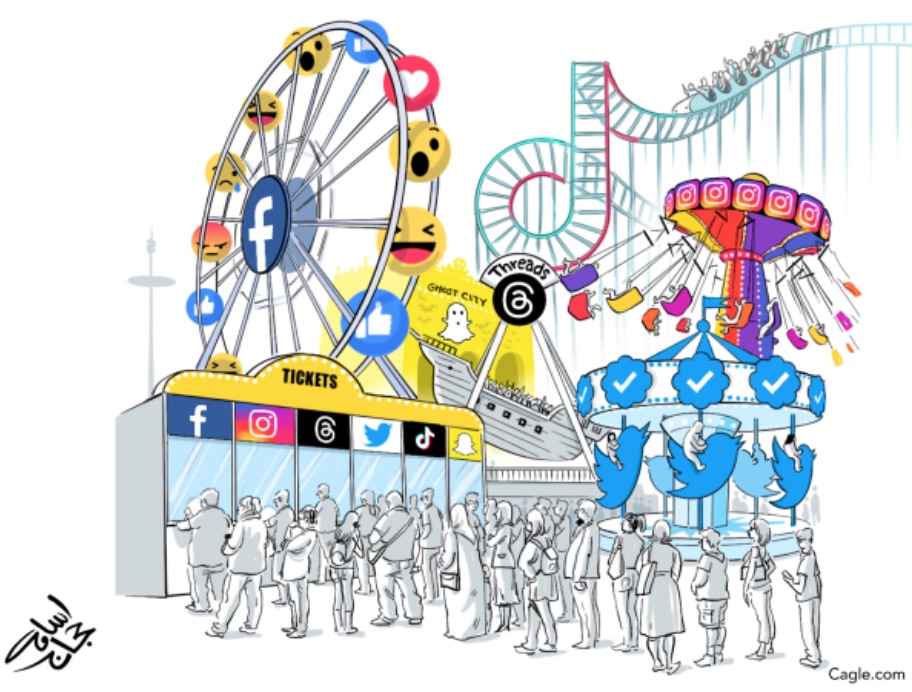Politics at the Speed of TikTok
Young Voters and the Grassroots Impact of Social Media

This past December, an astonishing headline hit mainstream media. According to a Harvard/Harris poll, a majority of Americans 18-24 believe “Israel should be ended and given to Hamas.” Again, 51 percent responded, “Yes.”
What happened next is even stranger. The news moved on. Crickets, instead of sirens, for a youth voting bloc Joe Biden desperately needs to win reelection this November.
Clearly, an information war is being waged. The U.S. and Israel are losing. Unfortunately it’s happening in a corner of cyberspace that’s nearly incomprehensible to anyone over 30.
Of course, it’s TikTok.
While the median Fox or MSNBC viewer is 70-plus, 60 percent of TikTokers are under 24. The standard generation gap is accelerating, as algorithm-based platforms like TikTok and Instagram don’t just drive the conversation, they’ve put a brick on the gas pedal and cut the brakes.
You don’t need to join them yourself, but it’s vital to know how they work.
The primary difference between Old Media (newspapers, TV, and radio) and New Media (search engines and social) is that New Media is limitless, asynchronous, and decentralized. Volume of information isn’t restricted to a page count or broadcast length, it’s freely accessible, 24/7, to infinitely indulge any user’s curiosity.
Speaking as an Old Millennial (35-42), I assumed TikTok was all lip-sync karaoke and dance routines. Then I tried it as a Creator, posting comedic rants for a year, gaining 10,000 followers. Zippy and randomized like a slot machine, it got addictive, so I retreated to a platform for people my own age: Instagram. Over time, however, “TT” and “IG” began to appear identical.
And what, exactly, does that mean?
Opening Instagram in late October, I clicked the “Discover” tab. The viral videos. A thumbnail appeared of my favorite lecturer on trauma and addiction, Gabor Mate. I clicked. Video popped up from a BBC interview with Piers Morgan. Asked about October 7, Mate, a Holocaust survivor himself, says it’s complex. “I used to be a Zionist,” he replied. Then he visited Gaza for himself — the “nightmare” — and cried for two weeks.
Dramatic, I thought. Next Video. Norman Finklestein appeared. A Jewish-American political scientist, author of several books about Gaza, passionately siding, also, with Palestine.
Back to back, two Jewish intellectuals, followed by — Next Video — “Jewish Voice For Peace” protesting in NYC. Within five minutes, the label of “antisemite” for critics of Israel got complicated, and that was only the beginning. Next Video.
Ilhan Pappe, Israeli historian and author of The Ethnic Cleansing of Palestine, gives a lecture about “The Nakba.” Meaning “catastrophe” in Arabic, The Nakba was the expulsion of 750,000-1 million native Palestinians between 1947-49 during Israel’s founding. It sounded, to me, like America’s own “Trail of Tears” we learned about in school. So I Googled the statistics. The Trail of Tears relocated 16,000 Cherokee; The Nakba displaced 50 times that number, with a similar figure — 16,000 Palestinians — massacred.
What? Why weren’t we taught that in school?
There’s plenty of Internet misinformation: Flat Earthers; January 6th Denialists; 9/11 Truthers. It’s harder to dismiss Gaza. Casual scrolling reveals scores of videos, prior to October 7, about Israel’s 75-year “Apartheid.” Unspeakable tragedy that it was, 10/7 appears to have also been a catalyst for many to dive into demystifying this eternal conflict for themselves.
What is Hamas, besides “terrorist organization”? It’s an Arabic acronym for resistance.
What are they resisting? An occupation. Even after Israel withdrew in 2005, Gaza remained under siege. Human Rights Watch called Gaza “an open air prison.” Poets — even of Jewish heritage — have referred to it as a “concentration camp.”
These are not my opinions; this is social media. An accelerated, addictive stream of photo and video content from around the globe. First a floppy-haired American student explains AIPAC, the Israeli lobbyist group, and screenshots a list showing its top recipient: Joe Biden, $4+ Million. Next Video.
A Gazan reporter named Motaz Azaiza, recognized by Time Magazine, shares drone footage with his 17 million followers of a bustling neighborhood reduced to dust. Next Video.
An ex-U.S. Marine, Greg J. Stoker, does military analysis of weapons being deployed in Gaza, and why Israel Defense Forces public statements don’t match its tactics. Next Video.
A press conference with U.S. National Security Coordinator John Kirby calling allegations of genocide “meritless” is remixed into a montage about “The Ten Stages of Genocide,” with accompanying video evidence.
This cannot be censored, controlled, or slowed. Every available fact is now at our fingertips. Old Media must respect, and address, these conversations. “Give Israel to Hamas” is a ludicrous concept, yet there are no adults in the room with real solutions, and trying to ignore the online chatter is a non-starter because then the mainstream loses any legitimacy.
The digital sphere has swung in a radical, reactionary direction. “Genocide Joe” trends daily, and Biden and the Democrats are sleepwalking into a buzzsaw this November. Nevermind that Trump and his allies would carry out the same policies. All we see, today, is a president who bypasses Congress to send more weapons to a country on trial for genocide with the International Court of Justice.
Here in America, kids are watching these horrors stream live. Crunching their stats, studying their history, and becoming very, very angry.
Mike Critelli is a filmmaker, author, and broadcaster who co-hosts “The Old Millennials” on KCSB-FM with his wife, Jill Critelli, a production designer with the Indy.
